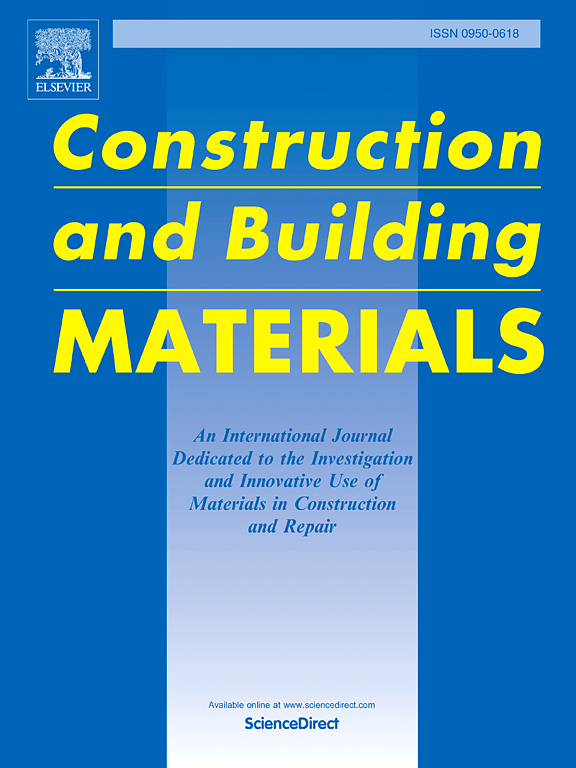实验室配制喷射混凝土多尺度对比评价及性能优化方法
IF 8
1区 工程技术
Q1 CONSTRUCTION & BUILDING TECHNOLOGY
引用次数: 0
摘要
隧道施工过程中的现场调整和多变的环境条件可能会影响喷射混凝土的质量,导致性能不一致和耐久性问题。本文探讨了在现场采用相同原料和配合比的情况下,在实验室条件下制备喷射混凝土的可行性。研究了砂比对喷射混凝土性能的影响。结果表明,实验室配制的喷射混凝土可以达到或超过现场配制的喷射混凝土的性能。在一定范围内提高掺砂量可以优化喷射混凝土的性能。对于表面粗糙度评估,实验室样品显示出较低的表面偏差(SD = 50.49 vs. 56.56)和3.25 %的高不均匀面积比(UAR),表明更均匀的粘贴覆盖。增加砂比可以提高表面光洁度,降低SD值。实验室试样早期抗压强度和28d抗压强度均达到35 MPa,强度增长速度快于现场试样。然而,62% %的砂比由于其高比表面积而略微降低了28天的强度。在相同配比下,实验室配制的喷射混凝土孔隙率略高于现场配制的喷射混凝土(MIP为11.63 % vs. 9.69 %),核磁共振T₂谱证实了相似的孔径分布,孔隙率随着砂比的增加从10.61 %上升到11.14 %。扫描电镜图像显示等效水化产物和C-S-H网络高达60% %砂比,微裂缝观察到62 %砂比。本文可为研究人员在实验室中灵活配制喷射混凝土提供参考。本文章由计算机程序翻译,如有差异,请以英文原文为准。
Multi-scale comparative evaluation and property-optimized method of laboratory-prepared shotcrete
On-site adjustments and variable environmental conditions during the tunnel construction potentially affect the quality of shotcrete, resulting in inconsistent properties and durability concerns. The article investigates the feasibility of preparing shotcrete under laboratory conditions with the identical raw materials and mix proportions employed on-site. And the effects of sand ratio on shotcrete properties are also studied. Results demonstrate that laboratory-prepared shotcrete can match or exceed the properties of site-prepared shotcrete. Improving the sand content within a specific range can optimize the shotcrete properties. For surface roughness evaluation, lab specimens exhibited a lower surface deviation (SD = 50.49 vs. 56.56) and a 3.25 % higher uneven area ratio (UAR), indicating more uniform paste coverage. Increasing the sand ratio can improve surface smoothness and reduce the SD value. Both the early-age and 28-day compressive strengths of the lab specimens reached 35 MPa, exhibiting a faster strength gain compared to the on-site samples. However, a 62 % sand ratio slightly reduced the 28-day strength due to its high specific surface area. Porosity of laboratory-prepared shotcrete was marginally higher than site‑prepared shotcrete (11.63 % vs. 9.69 % by MIP) under the same mix proportion, with NMR T₂ spectra confirming similar pore‑size distributions and porosity rising from 10.61 % to 11.14 % as sand ratio increased. SEM images revealed equivalent hydration products and C–S–H networks up to a 60 % sand ratio, with microcracking observed at a 62 % sand ratio. This article can serve as a reference for researchers to prepare shotcrete in the laboratory flexibly.
求助全文
通过发布文献求助,成功后即可免费获取论文全文。
去求助
来源期刊

Construction and Building Materials
工程技术-材料科学:综合
CiteScore
13.80
自引率
21.60%
发文量
3632
审稿时长
82 days
期刊介绍:
Construction and Building Materials offers an international platform for sharing innovative and original research and development in the realm of construction and building materials, along with their practical applications in new projects and repair practices. The journal publishes a diverse array of pioneering research and application papers, detailing laboratory investigations and, to a limited extent, numerical analyses or reports on full-scale projects. Multi-part papers are discouraged.
Additionally, Construction and Building Materials features comprehensive case studies and insightful review articles that contribute to new insights in the field. Our focus is on papers related to construction materials, excluding those on structural engineering, geotechnics, and unbound highway layers. Covered materials and technologies encompass cement, concrete reinforcement, bricks and mortars, additives, corrosion technology, ceramics, timber, steel, polymers, glass fibers, recycled materials, bamboo, rammed earth, non-conventional building materials, bituminous materials, and applications in railway materials.
 求助内容:
求助内容: 应助结果提醒方式:
应助结果提醒方式:


